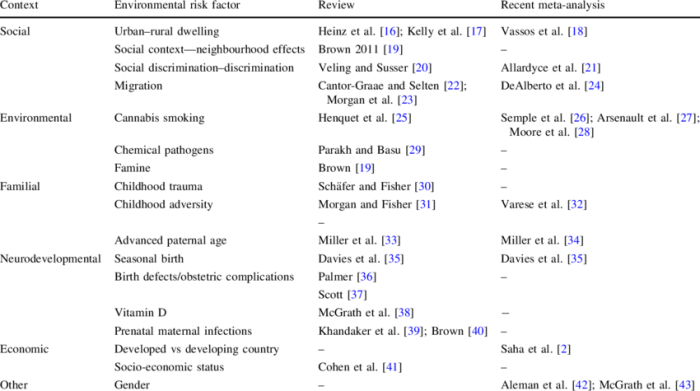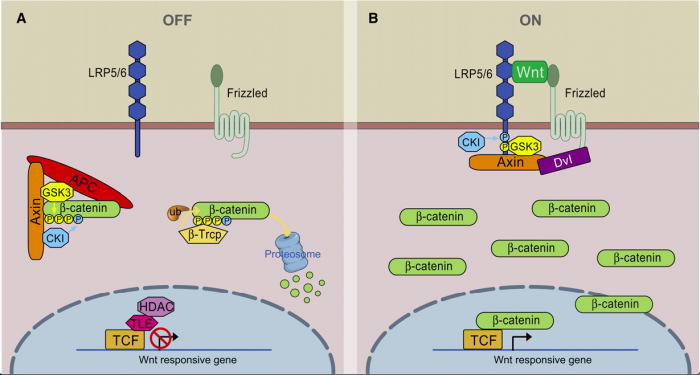A Developmental Issue?
While majority of Schizophrenia causation is a mystery to current scientists, the most prominent theory is one of brain development. People with schizophrenia have statistically shown delays in cognitive milestones, have smaller brain size, and are below the general population in cognitive ability. In addition, the majority of schizophrenia’s environmental factors interfere with proper brain development. These can include prenatal infection, prenatal famine, pre-eclampsia, infant infection, low birth weight, and even maternal depression.

Fig 1. A chart displaying numerous types of environmental factors listed for schizophrenia
Biological Support:
With a new emphasis on brain development, scientists found a strong correlation between decreased Wnt pathway activity and schizophrenia. When active, the Wnt pathway increases cellular levels of a molecule called beta-catenin which activates genes critical for development. When the pathway is inactive, the body naturally creates a destruction complex that breaks down beta-catenin, reducing its concentration, and preventing developmental genes from being expressed. In conclusion, it is important for this pathway to be active during critical developmental periods.

Fig 2. The left column shows the accumulation of beta-catenin when the Wnt pathway is active and the left column depicts the breakdown of beta-catenin when the pathway is inactive.
So What Went Wrong?
There is a molecule in everybody’s brain called Akt that aids in disassembling the natural destruction complex. This means that high levels of Akt increase levels of beta-catenin and result in increased expression of developmental genes. However, postpartum schizophrenic patients were found to have significantly lower levels of Akt in their brains. People with schizophrenia, therefore, have decreased Wnt pathway activity resulting in developmental problems. Most antipsychotics prescribed to schizophrenic patients target the Wnt pathway to alleviate symptoms. They usually increase the activity of Wnt signaling by increasing Akt activity, decreasing inhibitors of Akt, or directly inhibiting the destruction complex formation. While these drugs do a phenomenal job of treating the symptoms they still do not cure or reverse the permanent damage done to their brain.
Problems of Developmental Diseases:
The hard part about developmental disorders, like schizophrenia, is that majority of the damage is completed early in life. The devastation on the brain is then usually cemented after the individual reaches adulthood and brain development has ceased. This means that even if we did know how to treat schizophrenia, the treatment would have to be done early in a patient’s life to catch the developmental periods. This would have to lead to an intensive pre-natal screening and tests made specifically for diagnosing schizophrenia. Unfortunately, these options would probably be incredibly expensive which would prevent them from reaching their true at-risk population.
 Another problem is that schizophrenia is usually not diagnosed until the late teens to early twenties making it impossible to catch the disease early. Many of schizophrenia’s positive symptoms, including delusions and hallucinations, can be attributed to normal childhood behavior like imaginary friends and make-believe games. Then in the teenage years, most parents and doctors correlate symptoms to hormone imbalances and puberty. There is also a lot of maturing and development that occurs during this time so many doctors don’t want to diagnose a patient prematurely.
Another problem is that schizophrenia is usually not diagnosed until the late teens to early twenties making it impossible to catch the disease early. Many of schizophrenia’s positive symptoms, including delusions and hallucinations, can be attributed to normal childhood behavior like imaginary friends and make-believe games. Then in the teenage years, most parents and doctors correlate symptoms to hormone imbalances and puberty. There is also a lot of maturing and development that occurs during this time so many doctors don’t want to diagnose a patient prematurely.
Together these current problems make it hard to intervein early for schizophrenic patients. Future research should focus on finding early warning signs for the disease and its progression throughout early childhood and into adolescence. Majority of our research is only on adults since they are the only ones diagnosed, but much more could be learned from researching younger patients. Additionally, more extensive research must be found about the specific genes affected by decreased Akt activity.